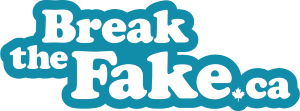Break the Fake: How to tell what's true online
Here are four quick and easy steps to find out the truth and share good information. Sometimes you only have to do one of these things, and most steps take less than a minute.
Using Fact-Checking Tools
Sometimes a single search can break the fake, if a professional fact-checker like Snopes has already done the work for you.
- You can use our custom search engine bit.ly/fact-search.
- If no reliable fact-checker has covered it yet, move on to Find the Source or Check Other Sources.
Find the Source
Because it’s so easy to copy and share things online, it’s important to find out where something originally came from before you decide whether or not to trust it.
- The easiest way to find the source is usually to follow links that will lead you to the original story.
- Use a search engine. See if you can find any information about where the story originally came from and do a search that includes that.
Verify the Source
Whether you’re looking at a website, a photo or video, or a news story, what really matters is whether or not the people who originally created it are trustworthy. You can’t always confirm that something is false, but if the source isn’t reliable you have no reason to believe it.
To find out if a source is reliable, ask three questions:
- Do they really exist?
“About Us” pages and profiles are easy to fake, so use a search engine or Wikipedia to find out if other people say they really exist. Pay the most attention to things that are hard to fake.
- Are they who they say they are?
It’s easy to pretend to be someone else online, so once you know the source really exists, you need to find out if what you’re looking at really came from them.
- Are they trustworthy?
For sources of general information, like newspapers, find out if they have a process for making sure they’re giving you good information, and a good track record of doing it.
For more specialized sources, find out whether they’re experts or authorities on that topic. Do a search and make sure that they are an authority in the right field.
Check Other Sources
This step may sometimes be the last one you do, but it could also be the first. It’s a quick way of finding out if a source might be biased, or if a news story is true.
- The News tab is better than the main Google search for this step. While not every source that’s included is perfectly reliable, they are all news outlets that really exist.
- Our custom news search, bit.ly/news-search, searches ten Canadian and international sources of reliable news.
- You can also use this step to find out whether something fits with what most of the experts on that topic agree – what’s called the consensus view. Use our custom search bit.ly/science-search to find the consensus on specialist topics like science and medicine.
Make sure to take at least one of these steps to double-check before you share anything you see online, every time. Because only you can break the fake.

This tip sheet is part of the Break the Fake project. This project has been made possible in part by the Government of Canada
